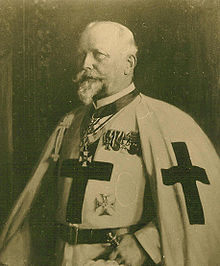Albrecht von Alvensleben-Schönborn
Albrecht von Alvensleben , from 1888 Count von Alvensleben-Schönborn (* December 16, 1848 in Wittenmoor ; † January 16, 1928 in Krampfer ) was a Prussian chamberlain, Erbtruchsess on Erxleben II, Uhrsleben , Ostrometzko , member of the Prussian manor and Komtur of the German Order , Ballei "Utrecht".
family
He comes from the Low German noble family von Alvensleben and was born on December 16, 1848 as the eldest son of Udo Gebhard Ferdinand von Alvensleben (1814–1879) and his wife Ehrengard, née von Kröcher (1821–1895) born in Wittenmoor. He was followed by three sisters and two brothers: Ludolf Udo von Alvensleben (1852–1923) and Joachim von Alvensleben (1856–1932), who in 1894 acquired the Falkenberg estate near Fürstenwalde . In 1873 he married Martha von Schönborn (1854–1915), heir to the Fideikommisses Ostrometzko in West Prussia. From this marriage there were eight children.
After the death of his father-in-law Gottlieb von Schönborn, Herr auf Ostrometzko and Girkau , in 1874, his mother-in-law Marie von Schönborn, daughter of Wilhelm von Schlichten , and his wife Martha owned the Girkau manor together until his wife became the sole owner through the death of his mother-in-law in 1894 .
Life
After attending the Knight Academy in Brandenburg , he first completed a forestry training with a forester's examination in Paderborn , then served as a one-year volunteer in Hussar Regiment No. 14 in Kassel , with which he participated in the Franco-German War of 1870/71. For his part in the capture of a cannon in the Battle of Wörth , he received the Iron Cross . He later rescued a French girl from drowning from the Marne, for which he was awarded the Rescue Medal. After the war he did practical agricultural training in Redekin .

After his marriage in 1873, he leased the Wittenmoor estate from his father. When his father died in 1879, he took over the Erxleben II estate, which he later leased out so that he could devote himself entirely to expanding his property in West Prussia. Wittenmoor inherited his brother Ludolf. After his coat of arms and family name had been combined with that of his wife, the heir to Ostrometzko, in 1880, Emperor Friedrich made him Count of Alvensleben-Schönborn in 1888 . The title was associated with Ostrometzko's possession. On the centenary of Ostrometzko's property in his wife's family, he was given a hereditary seat in the Prussian mansion in 1904. He also held the dignity of a royal Prussian chamberlain and an inheritance meal of the Halberstadt Monastery , was Commander of the Teutonic Order, Balley Utrecht, and Knight of the Order of St. John .
Erxleben Castle II (around 1865)
The old Ostrometzko Castle
power
Count Albrecht von Alvensleben was a successful, energetic entrepreneur. He not only expanded his agricultural and forestry holdings by acquiring the goods Glauchau ( Kulm district ), Tannhagen and Girkau ( Thorn district ) in West Prussia and Tessenow near Parchim (Mecklenburg), but also founded industrial operations - such as the mineral water fountain "Marienquelle" "in Ostrometzko, a company that still exists today and sells the water under the name" Ostromecko ".
When his wife died in 1915, he handed Ostrometzko over to his eldest son Joachim Martin (Jomar, 1877–1969) and resided permanently in Erxleben. After the First World War , West Prussia fell to Poland. He passed Glauchau to his third son Gebhard (1884–1960) and Tannhagen to the youngest son Ludolf (1891–1968). His sons living in West Prussia became Polish citizens in order to maintain the property. His second son Albrecht initially took over Erxleben II on a lease and inherited it after his father's death in 1928.
Count Albrecht von Alvensleben had a keen sense of family and did great service in maintaining his family's cultural values. In 1905 he arranged for the important family libraries to be cataloged and reorganized, for which he built his own library wing at Erxleben II Castle. The feudal library founded by Joachim I. von Alvensleben (1514–1588) comprised 5500 volumes, the Fideikommiss library 6700 volumes. In addition, there was the chapel library founded in 1580 with 2200 volumes, which at that time belonged jointly to the Alvensleben houses in Erxleben I and II and was only divided up at the end of the 1930s. The continuation of the Alvensleben family history published in 1930 by Dr. Hellmut Kretzschmar was thanks to him.
Count Albrecht von Alvensleben died on January 16, 1928 in Krampfer, in the house of his daughter Marie von Möllendorf and was buried in the crypt of the Erxleben palace chapel. He was the last Alvensleben to rest there. 340 years earlier Joachim I von Alvensleben was the first to be buried in the chapel.
literature
- Hellmut Kretzschmar : Historical news of the Alvensleben family since 1800 . Burg 1930, pp. 187–191.
- Udo von Alvensleben-Wittenmoor : The last five generations of Alvensleben in Erxleben II - 1782–1945 (written 1959). Published by the family von Alvensleben eV Falkenberg August 2008, pp. 37–41.
Web links
Individual evidence
- ↑ Hans von Maercker, History of the rural localities and the three smaller cities of the Thorn district , Danzig 1899/1900, p. 243
- ^ Website of the von Alvensleben family: Haus Ostrometzko ; State Archives Saxony-Anhalt: Royal Affairs for Count von Alvensleben-Schönborn on Ostrometzko (accessed on September 17, 2016)
| personal data | |
|---|---|
| SURNAME | Alvensleben-Schönborn, Albrecht von |
| ALTERNATIVE NAMES | Alvensleben-Schönborn, Albrecht Graf von (full name) |
| BRIEF DESCRIPTION | Prussian chamberlain, member of the Prussian manor house |
| DATE OF BIRTH | December 16, 1848 |
| PLACE OF BIRTH | Wittenmoor |
| DATE OF DEATH | January 16, 1928 |
| Place of death | Cramp |



